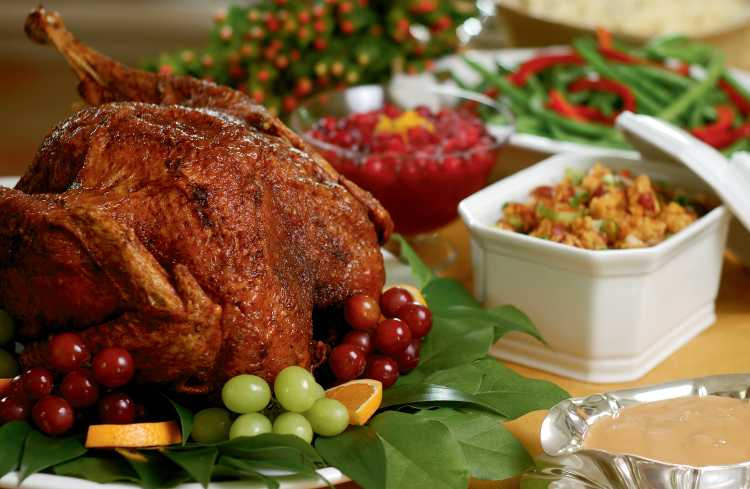Home > Lifestyle > Eats & Drinks > Deep-Fried Turkey Guide
Deep-Fried Turkey Guide

Turkey has been a holiday tradition in the New World since the pilgrims’ first Thanksgiving feast, and it is not likely that the noble native bird will ever fall from favor or fail to show up for special occasions. But the turkey on the table in the 21st century may have a new look, as more and more people are swayed to switch from traditional oven roasting to deep-frying their holiday bird.
Of course, every newcomer to deep-frying has the same question: How in the world do you fry a whole turkey?
The answer is simple: Very carefully!
Turkey Frying Checklist
- Butane burner or other heat source with adjustable control capable of producing at least 100,000 BTUs
- Tall, deep pot (20-22 gallons or larger) with lid
- Basket insert for the pot for ease in moving bird in and out
- Long clip-on thermometer that will measure up to at least 450 F
- Two long-handled cooking forks
- Oven mitts or long barbecue gloves
You can purchase a turkey-frying apparatus that includes the burner, pot, lifting rack and thermometer, available online or at home stores, including Home Depot; one brand is the King Kooker.
Deep-Frying Safety Tips
Whether a seasoned veteran a nervous beginner wondering which end of the turkey is up, all fry cooks need to follow basic safety rules.
Never fry a turkey inside the house. The high heat required and amount of oil used make it dangerous for the process to be conducted under any roof or overhang, in any kind of enclosure, or on a deck or any wooden platform.
Cooking equipment should always be set up on a driveway or dirt surface, away from anything flammable. Wear protective gear, heavy shoes, glasses or safety goggles, and always have an all-purpose fire extinguisher handy. Never allow children or pets to come near the cooking area.
Remember also that outdoor cooking requires extra attention and hand washing to prevent food-borne illness, especially important when handling raw poultry.
Amount of Oil to Use for Deep-Frying Turkey
To determine how much oil to use in the deep fryer, fill the pot with water and lower the unseasoned turkey into it. Water should cover the turkey without spilling over. Remove the turkey and measure the amount of water left in the pot. Discard the water and replace with the same amount of oil.
Use only oils that have high smoke points, such as peanut, canola or safflower oil. Peanut oil burns cleanly and doesn’t smoke at high temperatures – it’s the favorite in Louisiana for its flavor. Most turkeys require about five gallons of oil.
Selecting and Preparing the Turkey
Choose a fresh, or previously frozen, high-quality turkey of 9 to 14 pounds (10 is ideal), which must be thawed completely.
Before cooking, remove those pesky packets of giblets and the neck packed inside. In turkeys, the neck is stored in the body cavity and the giblets can be found in the neck cavity under the flap of skin. It is best to trim this skin flap to allow good oil flow while cooking. Trim off the tail, cut off the wing tips to the first joint, discard the wire truss that holds the legs in place and the pop-up timer if it has one. Bring the turkey to room temperature by running it under warm water, and dry it thoroughly with paper towels.
Rub dry seasonings inside and out, or inject the turkey with a large syringe filled with liquid seasoning (try our Mama Mia Marinade for turkey). Be sure to inject the marinade into muscle rather than under the skin because, as the skin cooks, a water-based marinade that comes in direct contact with hot oil causes the oil to pop and splatter dangerously.
Cooking the Turkey
Light your fryer’s burner and bring the oil to 375 F, which takes about 20 to 30 minutes. Lower the well-dried turkey, breast first with legs pointing up, into the oil. Check the oil temperature and increase the flame so the oil temperature is maintained at 350 F after the addition of the bird. If the temperature drops to 340 F or below, oil will begin to seep into the turkey and make it soggy. As the turkey cooks, occasionally move the bird around in the oil so that it does not scorch in the hotter oil near the heat source.
Turkeys without skin should cook for about 3 minutes per pound; if the skin is still on, cook for 3-1/2 minutes per pound. Check for doneness using a meat thermometer inserted into the thickest portion of the thigh. The temperature must reach at least 185 degrees and all juices should run clear.
Drain turkey completely in a large pan lined with several thicknesses of paper bags, cover with aluminum foil, and allow it to rest for 20 to 30 minutes before slicing. This will let the turkey finish cooking outside the oil and allow the juices to circulate back through the meat.
Let the oil cool for about 2 hours before storing it in a clean airtight container. The oil will last longer if stored in a dark, cool place.
Sounds easy, right? And the frying becomes almost an event in itself.



